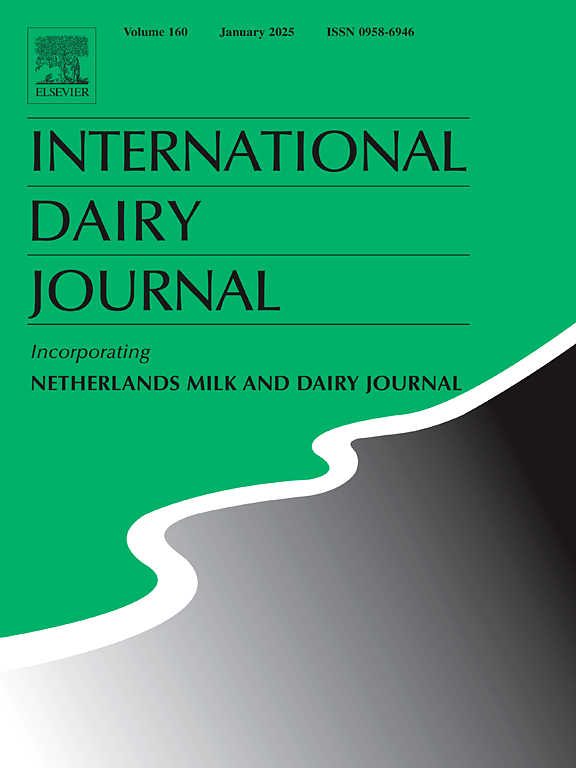Industrial Gouda cheese production shows batch-to-batch variations when using the same primary starter culture mixture as well as an impact of the brine on cheese quality
IF 3.1
3区 农林科学
Q2 FOOD SCIENCE & TECHNOLOGY
引用次数: 0
Abstract
Industrial production of Gouda cheeses is still affected by batch-to-batch variations, partly attributed to the rotational use of different starter culture mixtures. The current study aimed to unravel other variations by following two industrial Gouda cheese productions, made with the same starter culture mixture, up to 100 weeks. A culture-dependent analysis was combined with a culture-independent analysis through amplicon-based high-throughput sequencing (HTS) of the full-length 16S rRNA gene and meta-metabolomics, for both the cheese cores and rinds. Both cheese productions differed significantly in microbial counts throughout ripening. Lactococcus cremoris and Lactococcus lactis were the main species in the cheese cores. Additionally, Leuconostoc pseudomesenteroides was abundantly present, whereas Lacticaseibacillus paracasei was only abundant in one production, the cheeses of which had higher concentrations of free amino acids up to 26 weeks of ripening, and higher concentrations of D-lactic acid. The company's house microbiota differed from the cheese microbiota, with the exception that Loigolactobacillus rennini and Tetragenococcus halophilus were found in the brine and the cheeses. The former species caused high biogenic amine concentrations in the rinds during ripening. The microbial development of a new brine, including the fungal evolution by applying amplicon-based HTS of the whole fungal rRNA transcribed unit, went fast. However, the cheeses brined in the new brine did not contain Loil. rennini and the associated biogenic amines.
当使用相同的初级发酵剂混合物时,工业生产的豪达奶酪显示出批次之间的差异,以及盐水对奶酪质量的影响
豪达奶酪的工业生产仍然受到批次差异的影响,部分原因是轮流使用不同的发酵剂混合物。目前的研究旨在通过跟踪两种工业生产的豪达奶酪,用相同的发酵剂混合物,长达100周的时间来揭示其他变化。通过基于扩增子的16S rRNA全长测序(HTS)和元代谢组学,对奶酪芯和皮进行培养依赖性分析和培养非依赖性分析相结合。两种奶酪产品在整个成熟过程中微生物数量显著不同。干酪核中的主要菌种为乳酸菌乳球菌和乳酸菌乳球菌。此外,假肠芽孢杆菌大量存在,而副干酪乳杆菌仅在一种产品中大量存在,其中成熟26周的奶酪中游离氨基酸浓度较高,d -乳酸浓度较高。该公司的室内微生物群与奶酪的微生物群不同,除了在盐水和奶酪中发现了肾性干酪乳杆菌和嗜盐四小球菌。前一种在成熟过程中在果皮中引起高生物胺浓度。新型卤水的微生物发展,包括利用基于扩增子的全真菌rRNA转录单元HTS的真菌进化,进展迅速。然而,在新的盐水中浸泡的奶酪不含油脂。Rennini和相关的生物胺。
本文章由计算机程序翻译,如有差异,请以英文原文为准。
求助全文
约1分钟内获得全文
求助全文
来源期刊

International Dairy Journal
工程技术-食品科技
CiteScore
6.50
自引率
9.70%
发文量
200
审稿时长
49 days
期刊介绍:
The International Dairy Journal publishes significant advancements in dairy science and technology in the form of research articles and critical reviews that are of relevance to the broader international dairy community. Within this scope, research on the science and technology of milk and dairy products and the nutritional and health aspects of dairy foods are included; the journal pays particular attention to applied research and its interface with the dairy industry.
The journal''s coverage includes the following, where directly applicable to dairy science and technology:
• Chemistry and physico-chemical properties of milk constituents
• Microbiology, food safety, enzymology, biotechnology
• Processing and engineering
• Emulsion science, food structure, and texture
• Raw material quality and effect on relevant products
• Flavour and off-flavour development
• Technological functionality and applications of dairy ingredients
• Sensory and consumer sciences
• Nutrition and substantiation of human health implications of milk components or dairy products
International Dairy Journal does not publish papers related to milk production, animal health and other aspects of on-farm milk production unless there is a clear relationship to dairy technology, human health or final product quality.
 求助内容:
求助内容: 应助结果提醒方式:
应助结果提醒方式:


